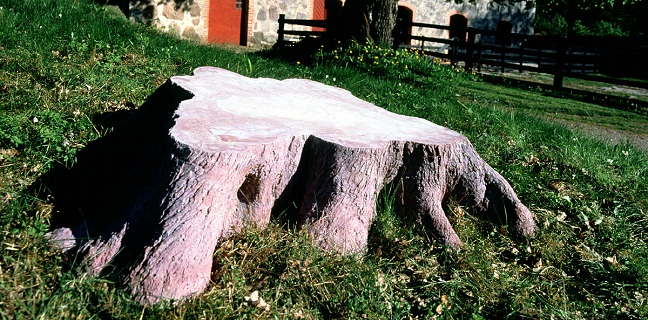
Allan McCollum
(Född/Born 1944, verksam i/works in New York)
Parables, 1998
12 avgjutningar, betong, pigment/12 casts, concrete, pigment
Diameter 200 cm
Med stöd från/With the support from Broby Modellindustri AB
For English please scroll down
När Allan McCollum besökte Wanås 1997 intresserade han sig särskilt för en almstubbe på parkeringsplatsen. Han hade under samma period läst en artikel om den holländska almsjukan som då härjade i Skåne. McCollum blev intresserad av stubbens former, liksom av almens betydelse i det sydsvenska landskapet, särskilt i gamla alléer. Till utställningen på Wanås 1998 lät han lät göra tolv identiska avgjutningar av stubben i betong, som placerades i olika delar av parken. De är färgade i grå, bruna och gula nyanser, som McCollum associerade med sjukdom.
Allan McCollum började arbeta som konstnär i slutet av 1960-talet. Han har sedan dess använt sig av massproduktionens metoder för att utmana idén om det unika konstverket. Ofta tillverkar han hundratals, ibland tusentals, till synes identiska objekt, som han presenterar tillsammans i omfattande installationer. Föremålen kan vara identiska, men många gånger innehåller de också små skiftningar i färgnyans, storlek eller utförande. Hans installationer refererar både till industri- och konsthistoria när han ifrågasätter konstvärldens besatthet av originalet och uppdelningen mellan det handgjorda och det industriellt tillverkade. Han ser i stället en demotratissk potential i det massproducerade föremålet fraför det autentiska konstverket, då det har möjlighet att komma fler till användning.
2006 gjorde McCollum den första utställningen med sitt pågående The Shapes Project. Han lyfter fram hur vi använder symboler för att skapa samhörighet samtidigt som vi eftersträvar det unika. McCollum kommenterar projektet: ”Det är en enkel idé att producera en unik emblematisk ‘form’ för varje person på vår planet.”
>>>
When Allan McCollum visited Wanås, he was particularly fascinated by the stump of an elm tree in the parking lot. At around the same time, he read an article about the Dutch elm disease that was ravaging the region. McCollum became interested in the shape of the stump, as well as the significance of elm trees to the southern Swedish landscape, especially along the old avenues of the area. For the exhibition at Wanås in 1998, he had twelve identical concrete casts of the stump made and placed in different areas of the park. They are tinted in grey, brown, and yellow hues, which McCollum associated with disease.
Allan McCollum began working as an artist in the end of the 1960s. He uses methods of mass production to challenge the idea of the unique artwork. He often produces hundreds, sometimes thousands, of seemingly identical objects, which he presents together in comprehensive installations. The objects can be identical, but many times they present small variations. His installations refer both to the history of industry, and of art, as he questions the supremacy of the original within the art world and the harsh distinction between hand-made and mass-produced objects. He sees instead a democratic potential in mass-produced objects, because they have the possibility of being used by more people.
In 2006, McCollum created the first exhibition of his current The Shapes Project. He emphasizes how we use symbols to create belonging at the same time as we aspire to uniqueness. McCollum comments on the project, saying, “It is a simple idea, producing a unique emblematic ‘shape’ for every person on our planet.”